|
| Method no.: |
PV2132 |
| |
|
| Control no.: |
T-PV2132-01-0403-M |
| |
|
| Target
concentration: |
1
mg/m3 |
| |
|
| Procedure: |
Samples are collected
by drawing a known volume of air through glass sampling tubes
containing Chromosorb 106. Samples are extracted with 99:1
carbon disulfide:
N,N-dimethylformamide and analyzed by GC using a flame
ionization detector. |
| |
|
| Recommended sampling
time and sampling rate: |
240 min at 0.2 L/min
(48 L) |
| |
|
| Reliable quantitation
limit: |
43
µg/m3 |
| |
|
| Status of method: |
Partially evaluated
method. This method has been subjected to established
evaluation procedures of the Methods Development Team and is
presented for information and trial use. |
| |
|
| March 2004 |
Mary
Eide |
| |
|
Methods Development Team
Industrial Hygiene
Chemistry Division
OSHA Salt Lake Technical Center
Sandy
UT 84070-6406
|
1. General
Discussion
1.1 Background
1.1.1 History
Air samples were
received at OSHA Salt Lake Technical Center collected on
Chromosorb 106 tubes with an analysis request for
di(ethylene glycol) ethyl ether acrylate (DEGEEA).
Chromosorb 106 is a nonpolar collection medium, therefore,
carbon disulfide was first selected for the extraction
solvent. While the extraction efficiency of dry spiked
samples was 98.2%, spiked samples exposed to humid air had
a loss of the DEGEEA in solution as they sat after
shaking, such that the recovery after 6 hours was 83.2%.
This indicated that there was a need for a polar modifier
in the extraction solvent. A mixture of 99:1 carbon
disulfide:N,N-dimethylformamide
(CS2:DMF) was tried next as the extraction
solvent. The average recovery was 98.6%, and there was no
loss of DEGEEA, in humidified samples, as the samples sat
on the autosampler. The analyte was found to be well
retained on the Chromosorb 106 tubes, with a retention
efficiency recovery of 98.6% and the storage stability
recovery was 97.8% on day 14 of ambient storage.
1.1.2 Toxic effects (This section is for
information only and should not be taken as the basis of
OSHA policy.)1
DEGEEA is a contact irritant affecting the skin,
eyes, upper respiratory tract, and mucous membrane. DEGEEA
may cause sensitization through skin contact. Prolonged
skin exposure may cause defatting and dermatitis.
1.1.3 Workplace exposure2
DEGEEA is used as a reactive multifunctional
monomer for UV curing of inks and coatings.
1.1.4
Physical properties and other descriptive information3,4
| synonyms: |
acrylic
acid, 2-(2-ethoxyethoxy)ethyl ester; carbitol
acrylate; ethylcarbitol acrylate; ethyldiglycol
acrylate; 2-(2-ethoxyethoxy)ethyl acrylate; ethyl
acrylate ester monomer; 2-propenoic acid,
2-(2-ethoxy) ethyl ester; Reactomer RC-20 |
| CAS
number: |
7328-17-8 |
| IMIS5 |
D945 |
| molecular
weight: |
188.22 |
| density
(g/mL): |
1.016 |
| melting
point: |
-66
°C |
| boiling
point: |
95 °C |
| appearance: |
clear
liquid |
| flash
point: |
113 °C (235
°F) (closed cup) |
| odor: |
ester-like |
| molecular
formula: |
C9H16O4 |
| solubility: |
soluble in
most organic solvents |
| autoignition temperature: |
210 °C (410
°F) |
structural formula:

This method was evaluated according to the
OSHA SLTC "Evaluation Guidelines for Air Sampling Methods
Utilizing Chromatographic Analysis"6.
The Guidelines define analytical parameters; specify required
laboratory tests, statistical calculations and acceptance
criteria. The analyte air concentrations throughout this
method are based on the recommended sampling and analytical
parameters.
1.2 Detection limit of the overall procedure
(DLOP) and reliable quantitation limit (RQL)
The
DLOP is measured as mass per sample and expressed as
equivalent air concentration, based on the recommended
sampling parameters. Ten samplers were spiked with equal
descending increments of analyte, such that the highest
sampler loading was 9.14 µg of DEGEEA. This is the amount
spiked on a sampler that would produce a peak at least 10
times the response for a sample blank. These spiked samplers
were analyzed with the recommended analytical parameters,
and the data obtained used to calculate the required
parameters (standard error of estimate and slope) for the
calculation of the DLOP. The slope was 715 and the SEE was
148. The RQL is considered the lower limit for precise
quantitative measurements. It is determined from the
regression line parameters obtained for the calculation of
the DLOP, providing 75% to 125% of the analyte is recovered.
The DLOP and RQL were 0.62 µg and 2.07 µg, respectively. The
recovery at the RQL was 98.5%.
Table 1.2
Detection Limit of the Overall
Procedure for DEGEEA
|
mass per
sample
(µg) |
area
counts
(µV-s) |
|
| 0.00 |
0 |
| 0.91 |
550 |
| 1.83 |
1021 |
| 2.74 |
1635 |
| 3.66 |
2216 |
| 4.57 |
2872 |
| 5.49 |
3640 |
| 6.40 |
4339 |
| 7.32 |
4939 |
| 8.23 |
5720 |
| 9.14 |
6859 |
|
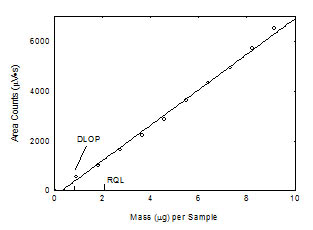
Figure 1.2.1 Plot of data to determine
the DLOP/RQL for DEGEEA. (y = 715x -
226) |
Below is a chromatogram of DEGEEA near the
RQL. The recovery at the RQL was 98.5%.
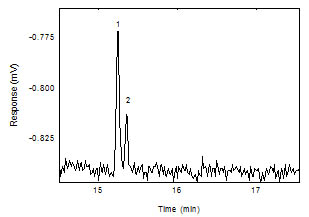
Figure 1.2.2 Chromatogram of the DEGEEA
near the RQL. (Key: (1) DEGEEA, (2)
interferant) | 2. Sampling Procedure
All safety
practices that apply to the work area being sampled should be
followed. The sampling equipment should be attached to the
worker in such a manner that it will not interfere with work
performance or safety.
2.1 Apparatus
2.1.1 Samples are collected using a personal
sampling pump calibrated, with the sampling device
attached, to within ±5% of the recommended flow rate.
2.1.2 Samples are collected with 7-cm × 4-mm i.d.
× 7-mm o.d. glass sampling tubes packed with two sections
(100/50 mg) of Chromosorb 106. The sections are held in
place with foam plugs and with a glass wool plug at the
front. For this evaluation, commercially prepared sampling
tubes were purchased from SKC, Inc. (Catalog no. 226-110,
lot 2573). 2.2 Reagents
None required.
2.3 Technique
2.3.1 Immediately before sampling, break off
the ends of the flame-sealed tube to provide an opening
approximately half the internal diameter of the tube. Wear
eye protection when breaking the tube. Use tube holders to
minimize the hazard of broken glass. All tubes should be
from the same lot.
2.3.2 The smaller section of
the adsorbent tube is used as a back-up and is positioned
nearest the sampling pump. Attach the tube holder to the
sampling pump so that the adsorbent tube is in an
approximately vertical position with the inlet facing down
during sampling. Position the sampling pump, tube holder
and tubing so they do not impede work performance or
safety.
2.3.3 Draw the air to be sampled directly
into the inlet of the tube holder. The air being sampled
is not to be passed through any hose or tubing before
entering the sampling tube.
2.3.4 After sampling
for the appropriate time, remove the adsorbent tube and
seal it with plastic end caps. Seal each sample end-to-end
with an OSHA-21 form as soon as possible.
2.3.5
Submit at least one blank sample with each set of samples.
Handle the blank sample in the same manner as the other
samples except draw no air through it.
2.3.6
Record sample air volumes (liters), sampling time
(minutes), and sampling rate (L/min) for each sample,
along with any potential interferences on the OSHA-91A
form.
2.3.7 Submit the samples to the laboratory
for analysis as soon as possible after sampling. If delay
is unavoidable, store the samples at refrigerator
temperature. Ship any bulk samples separate from the air
samples. 2.4 Extraction efficiency
The
extraction efficiency was determined by spiking front
sections of Chromosorb 106 tubes with DEGEEA at 0.1 to 2
times the target concentration, based on a 48-L air volume,
for a loading of 4.57 to 91.4 µg/sample. These samples were
stored overnight at ambient temperature and then extracted
with 1 mL of extracting solvent for 30 minutes with shaking,
and analyzed by GC-FID. The mean extraction efficiency over
the studied range was 98.6%. The wet extraction efficiency
was determined at 1 times the target concentration by liquid
spiking the analyte onto Chromsorb 106 tubes which had 48-L
humid air (absolute humidity of 15.9 mg/L of water, about
80% relative humidity at 22.2 °C) drawn through them
immediately before spiking. The mean recovery for the wet
samples was 98.9%.
Table 2.4
Extraction Efficiency (%) of
DEGEEA
|
level
|
sample number
|
mean
|
x
target
concn |
µg
per
Sample |
1 |
2 |
3 |
4 |
5 |
6 |
|
|
| 0.1 |
4.57 |
97.4 |
97.2 |
98.2 |
98.3 |
97.0 |
97.6 |
97.6 |
| 0.5 |
22.9 |
99.1 |
99.3 |
98.5 |
98.4 |
98.8 |
99.0 |
98.9 |
| 1.0 |
45.7 |
99.1 |
98.5 |
98.9 |
98.6 |
99.2 |
98.8 |
98.9 |
| 1.5 |
68.6 |
99.0 |
98.3 |
99.3 |
98.7 |
99.4 |
97.9 |
98.8 |
| 2.0 |
91.4 |
98.9 |
99.0 |
99.1 |
99.0 |
99.4 |
98.8 |
99.0 |
| |
|
|
|
|
|
|
|
|
| 1.0
(wet) |
45.7 |
98.9 |
99.0 |
98.6 |
98.5 |
99.1 |
99.3 |
98.9 |
|
2.5
Retention efficiency
Six Chromosorb 106 tubes were
spiked with 91.4 µg (1.9 mg/m3) of DEGEEA in the
front sections, and allowed to equilibrate for 6 h. The
tubes had 48-L humid air (absolute humidity of 15.9 mg/L of
water, about 80% relative humidity at 22.2 °C)
pulled through them at 0.2 L/min. The samples were extracted
and analyzed. The mean recovery was 98.6%. There was no
analyte found on the back-up section of any of the tubes.
Table 2.5
Retention Efficiency (%) of
DEGEEA |
|
section
|
sample number
|
mean
|
| |
1 |
2 |
3 |
4 |
5 |
6 |
|
|
| front of spiked tube |
99.1 |
98.3 |
99.0 |
98.8 |
98.5 |
97.9 |
98.6 |
| rear of spiked tube |
0.0 |
0.0 |
0.0 |
0.0 |
0.0 |
0.0 |
0.0 |
| total |
99.1 |
98.3 |
99.0 |
98.8 |
98.5 |
97.9 |
98.6 |
|
2.6 Sample
Storage
Fifteen Chromosorb 106 tubes were each
spiked with 45.7 µg (0.95 mg/m3) of DEGEEA. They
were allowed to equilibrate for 6h, then they had 48 L of
air, with an absolute humidity of 15.7 milligrams of water
per liter of air (about 80% relative humidity at 23 °C),
drawn through them. Three samples were analyzed immediately,
and the rest were sealed. Six were stored at room
temperature (23 °C), while the other six were stored at
refrigerated temperature (4 °C). Three samples stored at
room temperature and three samples stored at refrigerated
temperature were analyzed after 7 days and the remaining
three of each set after 14 days. The amounts recovered
indicate good storage stability for the time period studied.
Table 2.6
Storage Test for DEGEEA |
|
| time
(days) |
ambient storage recovery (%) |
refrigerated storage recovery (%) |
|
| 0 |
99.5 |
98.3 |
98.9 |
|
|
|
| 7 |
98.8 |
98.5 |
97.7 |
98.9 |
99.3 |
98.0 |
| 14 |
97.5 |
98.7 |
97.2 |
98.5 |
99.2 |
97.9 |
|
2.7
Recommended air volume and sampling rate
Based on
the data collected in this evaluation, 48-L air samples
should be collected at a sampling rate of 0.2 L/min for 240
minutes.
2.8 Interferences (sampling)
2.8.1 There are no known compounds which will
severely interfere with the collection of DEGEEA.
2.8.2 Suspected interferences should be reported
to the laboratory with submitted samples
3. Analytical
Procedure
Adhere to the rules set down in your
Chemical Hygiene Plan. Avoid skin contact and inhalation of
all chemicals and review all appropriate MSDSs.
3.1 Apparatus
3.1.1 A gas chromatograph equipped with an FID
detector. For this evaluation, an Agilent 6890 GC was
used.
3.1.2 A GC column capable of separating
DEGEEA from the extraction solvent, internal standard, and
any potential interferences. A 60-m × 0.32-mm i.d. DB-1
(1-µm df) capillary column (J&W Scientific, Folsom,
CA) was used in this evaluation.
3.1.3 An
electronic integrator or some other suitable means of
measuring peak areas. A Waters Millennium32
Data System and an Agilent integrator 3396 were used in
this evaluation.
3.1.4 Glass vials with
poly(tetrafluoroethylene)-lined caps. For this evaluation
2-mL vials were used.
3.1.5 A dispenser capable of
delivering 1.0 mL of extraction solvent to prepare
standards and samples. If a dispenser is not available, a
1.0-mL volumetric pipet may be used.
3.1.6
Volumetric flasks – 10-mL and other convenient sizes for
preparing standards.
3.1.7 Calibrated 10-µL or
20-µL syringe for preparing standards.
3.1.8 A
mechanical shaker. An Eberbach mechanical shaker was used
in this evaluation. 3.2 Reagents
3.2.1 Di(ethylene glycol) ethyl ether
acrylate, technical grade. Aldrich 90% (lot 07619DF) was
used in this evaluation.
3.2.2 Carbon disulfide,
Reagent grade. EM Science Omni-Solv® 99.99% (lot
43279343), was used in this evaluation.
3.2.3
N,N-Dimethylformamide,
anhydrous. Aldrich 99.8% (lot 04643LA) was used in this
evaluation.
3.2.4 p-Cymene, reagent grade. Aldrich 99%
(lot 11703TR) was used in this evaluation
3.2.5
The extraction solvent solution was 99:1 carbon
disulfide:DMF with 0.25 µL/mL of p-cymene as internal standard.
3.3 Standard preparation
3.3.1 Prepare at least two stock standards by
spiking microliter quantities of DEGEEA from a microliter
syringe into volumetric flasks containing the extraction
solution. Working analytical standards are prepared by
serial dilutions of the stock standard with the extraction
solvent. A stock standard of 5 µL/10 mL (0.5 µL/mL) is
equivalent to 457 µg/mL, based on the density and the
purity of 90%. A 1:10 dilution of this stock standard is
45.7 µg/mL, which is equivalent to 0.95 mg/m3
based on a 48 L air volume.
3.3.2 Bracket sample
concentrations with standard concentrations. If, upon
analysis, sample concentrations fall outside the range of
prepared standards, prepare and analyze additional
standards to confirm instrument response, or dilute high
samples with extraction solvent and reanalyze the diluted
samples. For this evaluation, standards in the range of
0.91 to 183 µg/mL were used. A check standard from a
second source should be prepared to check the calibration.
3.4 Sample preparation
3.4.1 Remove the plastic end caps from the
sample tubes and carefully transfer each adsorbent section
to separate 2-mL vials. Discard the glass tube, urethane
foam plug and glass wool plug.
3.4.2 Add 1.0 mL of
extraction solvent to each vial using the same dispenser
as used for preparation of standards.
3.4.3
Immediately seal the vials with
poly(tetrafluoroethylene)-lined caps.
3.4.4
Agitate the vials on a shaker or rotator for 30 minutes.
3.5 Analysis
3.5.1 Gas chromatographic conditions
GC conditions
|
| zone
temperature: |
initial 50
°C, hold 1 min, ramp at 10 °C/min to 170°C, hold 7
min |
| |
250 °C
(injector) |
| |
250 °C
(detector) |
| run
time: |
20
min |
| column gas
flow: |
3.2 mL/min
(hydrogen) |
| injection
size: |
1.0 µL
(10:1 split) |
| column: |
60-m ×
0.32-mm i.d. capillary DB-1 (df = 1 µm) |
| retention
times: |
4.0 min
(carbon disulfide); 7.0 min (DMF); 11.8 min (p-cymene); 15.2 min
(DEGEEA) |
FID conditions
|
| hydrogen
flow: |
30
mL/min |
| air
flow: |
400
mL/min |
| makeup
flow: |
25 mL/min
(nitrogen) |
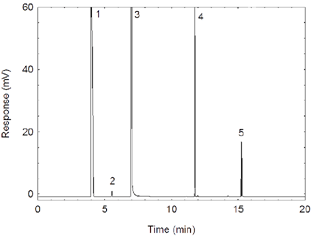
Figure 3.5.1 A chromatogram of 45.7
µg/mL DEGEEA in 99:1 CS2:DMF with 0.25
µ/mL p-cymene internal
standard. (Key: (1) CS2; (2) benzene
contaminant in the CS2; (3) DMF; (4)
p-cymene; (5)
DEGEEA) |
3.5.2 Peak areas are measured by an
integrator or other suitable means.
3.5.3 An
internal standard (ISTD) calibration method is used. A
calibration curve can be constructed by plotting response
of standard injections versus micrograms of analyte per
sample. Bracket the samples with freshly prepared
analytical standards over the range of
concentrations.
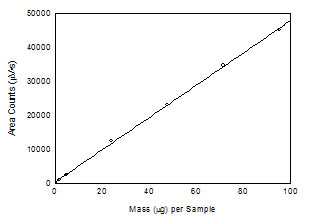
Figure 3.5.2 Calibration curve of DEGEEA.
(y = 476x + 388) | 3.6 Interferences (analytical)
3.6.1 Any compound that produces a GC response
and has a similar retention time as the analyte is a
potential interference. If any potential interferences
were reported, they should be considered before samples
are extracted. Generally, chromatographic conditions can
be altered to separate an interference from the analyte.
3.6.2 When necessary, the identity or purity of an
analyte peak may be confirmed by GC-mass spectrometry or
by another analytical procedure. The mass spectrum in
Figure 3.6.2 was from an analytical standard run on an
Agilent 6890 GC with a 5973 Mass Selective Detector.
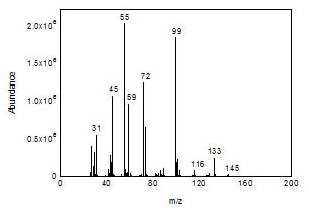
Figure 3.6.2 Mass spectrum of
DEGEEA | 3.7 The amount of analyte per sampler is
obtained from the appropriate calibration curve in terms of
micrograms per sample, uncorrected for extraction
efficiency. This total amount is then corrected by
subtracting the total amount (if any) found on the blank.
The air concentration is calculated using the following
formulas.
| where: |
CM is concentration by
weight (mg/m3) |
| M is micrograms per sample |
| V is liters of air sampled |
| EE is extraction
efficiency, in decimal
form |
4. Recommendations for Further Study
Collection, reproducibility, and other detection limit
studies need to be performed to make this a fully validated
method.
References
1. Material Safety Data Sheet: Di(ethylene glycol)
ethyl ether acrylate, Aldrich Chemical Co., Milwaukee, WI,
(accessed 10/3/03).
2. Material Safety Data Sheet:
Diethylene glycol ethyl ether acrylate, Chemwatch, Victoria,
Australia, (accessed 12/17/03).
3. Material Safety
Data Sheet: Diethylene glycol ethyl ether acrylate, Aldrich
Chemical Co., Milwaukee, WI. (accessed 10/03/03).
4.
Material Safety Data Sheet: Ethyldiglycol acrylate, http://www.osha-slc.gov/pls/oshaweb/owaredirect.html?p_url=http://www.corporate.basf.com/en/?id=V00-pM9CB4qCBbcp459,
(accessed 12/17/03).
5. OSHA Chemical sampling
Information, http://www.osha-slc.gov/
(accessed 12/17/03).
6. Burright, D.; Chan, Y.; Eide,
M.; Elskamp, C.; Hendricks, W.; Rose, M. C. Evaluation Guidelines for Air Sampling Methods
Utilizing Chromatographic Analysis; OSHA Salt Lake
Technical Center, U.S. Department of Labor: Salt Lake City,
UT, 1999.
|
| |
| |

